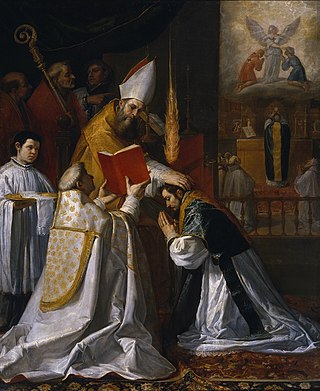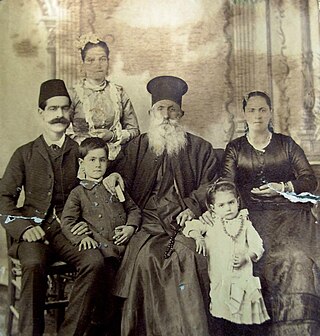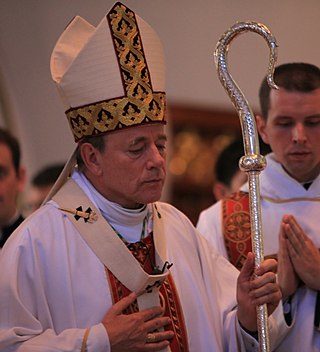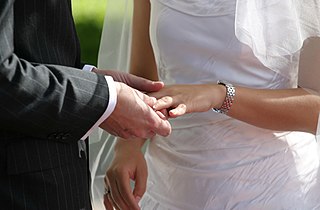Celibacy is the state of voluntarily being unmarried, sexually abstinent, or both, usually for religious reasons. It is often in association with the role of a religious official or devotee. In its narrow sense, the term celibacy is applied only to those for whom the unmarried state is the result of a sacred vow, act of renunciation, or religious conviction. In a wider sense, it is commonly understood to only mean abstinence from sexual activity.

In certain Christian denominations, holy orders are the ordained ministries of bishop, priest (presbyter), and deacon, and the sacrament or rite by which candidates are ordained to those orders. Churches recognizing these orders include the Catholic Church, the Eastern Orthodox, Oriental Orthodox, Anglican, Assyrian, Old Catholic, Independent Catholic and some Lutheran churches. Except for Lutherans and some Anglicans, these churches regard ordination as a sacrament.

There have been many cases of sexual abuse of children by priests, nuns, and other members of religious life in the Catholic Church. In the late 20th and early 21st centuries, the cases have involved many allegations, investigations, trials, convictions, acknowledgement and apologies by Church authorities, and revelations about decades of instances of abuse and attempts by Church officials to cover them up. The abused include mostly boys but also girls, some as young as three years old, with the majority between the ages of 11 and 14. Criminal cases for the most part do not cover sexual harassment of adults. The accusations of abuse and cover-ups began to receive public attention during the late 1980s. Many of these cases allege decades of abuse, frequently made by adults or older youths years after the abuse occurred. Cases have also been brought against members of the Catholic hierarchy who covered up sex abuse allegations and moved abusive priests to other parishes, where abuse continued.
Clerical celibacy is the requirement in certain religions that some or all members of the clergy be unmarried. Clerical celibacy also requires abstention from deliberately indulging in sexual thoughts and behavior outside of marriage, because these impulses are regarded as sinful. Vows of celibacy are generally required for monks and nuns in Christianity, Buddhism, Hinduism, Jainism and other religions, but often not for other clergy.

Clerical marriage is the practice of allowing Christian clergy to marry. This practice is distinct from allowing married persons to become clergy. Clerical marriage is admitted among Protestants, including both Anglicans and Lutherans. Some Protestant clergy and their children have played an essential role in literature, philosophy, science, and education in Early Modern Europe.

Fabian Wendelin Bruskewitz is an American prelate of the Roman Catholic Church who served as bishop of the Diocese of Lincoln in Nebraska, from 1992 to 2012.
In Christianity, the term secular clergy refers to deacons and priests who are not monastics or otherwise members of religious life. Secular priests are priests who commit themselves to a certain geographical area and are ordained into the service of the residents of a diocese or equivalent church administrative region. That includes serving the everyday needs of the people in parishes, but their activities are not limited to that of their parish.
Instruction Concerning the Criteria for the Discernment of Vocations with Regard to Persons with Homosexual Tendencies in View of Their Admission to the Seminary and to Holy Orders is a document published in November 2005 by the Congregation for Catholic Education, one of the top-level offices of the Catholic Church.

The sacrament of holy orders in the Catholic Church includes three orders: bishops, priests, and deacons, in decreasing order of rank, collectively comprising the clergy. In the phrase "holy orders", the word "holy" means "set apart for a sacred purpose". The word "order" designates an established civil body or corporation with a hierarchy, and ordination means legal incorporation into an order. In context, therefore, a group with a hierarchical structure that is set apart for ministry in the Church.

John Michael Miller, CSB is a Canadian bishop of the Catholic Church. He is the Archbishop of Vancouver, succeeding to the position in 2009 after serving as its coadjutor archbishop and as Secretary of the Congregation for Catholic Education. Prior to his appointment as bishop, he was a professor and academic administrator at the University of St. Thomas (UST) in Houston.

The priesthood is the office of the ministers of religion, who have been commissioned ("ordained") with the Holy orders of the Catholic Church. Technically, bishops are a priestly order as well; however, in layman's terms priest refers only to presbyters and pastors. The church's doctrine also sometimes refers to all baptised (lay) members as the "common priesthood", which can be confused with the ministerial priesthood of the consecrated clergy.
Clerical celibacy is the discipline within the Catholic Church by which only unmarried men are ordained to the episcopate, to the priesthood in the Latin Church, and similarly to the diaconate. In other autonomous particular churches, the discipline applies only to the episcopate. According to Jason Berry of The New York Times, "The requirement of celibacy is not dogma; it is an ecclesiastical law that was adopted in the Middle Ages because Rome was worried that clerics' children would inherit church property and create dynasties." For several hundred years after the imposition of celibacy on secular (non-monastic/religious) clergy the sale of church offices continued. The first male issue of non-married concubines of celibate clergy became set to continue the dynasty. To curtail this clerical abuse, the Latin Church imposed a ban on the ordination of bastards. This policy ended almost 800 years later in the 20th century.
The Catholic Church condemns same-sex sexual activity and denies the validity of same-sex marriage. While the Church opposes "unjust" discrimination against homosexual persons, it supports what it considers "just" discrimination in the employment of teachers or athletic coaches, in adoption, in the military and in housing. The Catechism of the Catholic Church promulgated by Pope John Paul II considers sexual activity between members of the same sex to be a grave sin against chastity and sees homosexual attraction as objectively disordered. However, the Catechism also states that homosexuals "must be accepted with respect, compassion, and sensitivity". This teaching has developed through papal interventions, and influenced by theologians, including the Church Fathers.
Gerald Michael Cushing Fitzgerald, s.P. was an American Catholic priest known for founding the Congregation of the Servants of the Paraclete, which operates centers for priests dealing with challenges such as alcoholism, substance abuse and sexual misconduct.
The ordination of lesbian, gay, bisexual and/or transgender (LGBT) clergy who are open about their sexuality or gender identity; are sexually active if lesbian, gay, or bisexual; or are in committed same-sex relationships is a debated practice within some contemporary Christian denominations.

Sex and gender roles in the Roman Catholic Church have been the subject of both intrigue and controversy throughout the Church's history. The cultural influence of the Catholic Church has been vast, particularly upon Western society. Christian concepts, introduced into evangelized societies worldwide by the Church, had a significant impact on established cultural views of sex and gender roles. Human sacrifice, slavery, infanticide and polygamy practiced by cultures such as those of the Roman Empire, Europe, Latin America and parts of Africa came to an end through Church evangelization efforts. Historians note that Catholic missionaries, popes and religious were among the leaders in campaigns against slavery, an institution that has existed in almost every culture and often included sexual slavery of women. Christianity affected the status of women in evangelized cultures like the Roman Empire by condemning infanticide, divorce, incest, polygamy and marital infidelity of both men and women. Some critics say the Church and teachings by St. Paul, the Church Fathers, and scholastic theologians perpetuated a notion that female inferiority was divinely ordained, while current Church teaching considers women and men to be equal, different, and complementary.
The debate on the causes of clerical child abuse is a major aspect of the academic literature surrounding Catholic sex abuse cases.
The ecclesiastical response to Catholic sexual abuse cases is a major aspect of the academic literature surrounding the Church's child sexual abuse scandal. The Catholic Church's response to the scandal can be viewed on three levels: the diocesan level, the episcopal conference level and the Vatican. Responses to the scandal proceeded at all three levels in parallel with the higher levels becoming progressively more involved as the gravity of the problem became more apparent.
The Curial response to Catholic sexual abuse cases was a significant part of the Church's response to Catholic sexual abuse cases. Its policies have shifted from favoring secrecy in the 20th century to active reform and apologies in the 21st century. Under the current leadership of Pope Francis, the issue has been addressed through direct instructions to report cases of sexual abuse and revoking the former policies of secrecy.








